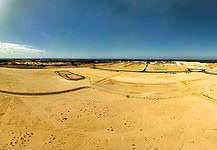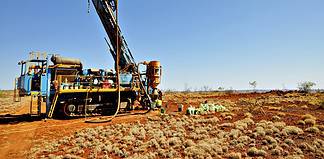Groundwater drilling at the Nolans NdPr project in the Northern Territory. Image Arafura Resources.
BY ELIZABETH FABRI
NEODYMIUM and praseodymium – or NdPr for short – has been labelled one of the “biggest blind spots of today’s global commodity market”, but interest is beginning to pick up for rare earth elements with analysts forecasting strong demand to come out of China in the early 2020s.
It’s in our mobile phones, the hard disc drive of our laptops and the NdFeB magnets in the electric vehicles soon to be hitting our roads – yet there is still a level of restraint within the investment community towards NdPr.
To date, China has been the biggest producer of the rare earths material.
But an emerging group of ASX-players were now getting attention, as the NdPr price increased on the back of the fast-growing electric vehicle sector.
ASX-listed Lynas Corporation, which owns and operates the Mt Weld mine right here in Australia, is one miner in the spotlight.
The only producer and processor of rare earths currently outside of China, Lynas produced 1447 tonnes of NdPr in the June quarter.
Lynas chief executive Amanda Lacaze said the miner’s previous debt situation meant it needed to sell all of its NdPr product for cash immediately, but recent market dynamics enabled the company to hold back 100 tonnes of inventory “rather than sell at current prices”.
Near-term producers Arafura Resources and Peak Resources – currently seeking finance to develop their respective Nolans and Ngualla projects – also had their name up in lights.
In 2017, Peak Resources Sales, Marketing and Business Development general manager Michael Prassas published a white paper titled ‘Ndpr the biggest blind spot in the global commodity market’ which aimed to educate potential investors about NdPr, exploring the fundamentals of the market and the company’s outlook.
Mr Prassas said he was bullish on the market for NdPr over the mid-term.
“I believe NdPr is the biggest blind spot in the global commodity market and that the next decade will provide all the evidence to support this assumption,” Mr Prassas told The Australian Mining Review.
“During 2017 China allocated billions of USD to NdPr relevant applications and their related infrastructure and applications, such as, industrial parks, wind farms, high speed magnet trains and electric vehicle development.
“Many people are unaware that nine out of 10 mobility applications that use a lithium-cobalt-graphite battery are also using an NdPr permanent magnet motor.
“With each of these motors representing a minimum incremental demand of 1kg NdPr oxide, the math speaks for itself.”
Mr Prassas said he expected that by 2020 the market would see a very different rare earth pricing landscape than today.
“By 2025 all car manufacturers will have a comprehensive and complete new energy vehicle range in the market, equivalent to the diversification of the internal combustion engine product portfolio today,” he said.
“At that time I anticipate that the electric vehicle segment will represent 15-25 per cent of the global annual passenger car sales, equating to approximately 15-25 million electric vehicles sold every year.
“These projections are also supported by the data which I continuously collect from the lithium sector as well as the tracked overall communicated installed industrial lithium battery manufacturing capacity.”
Arafura Resources managing director Gavin Lockyer said he was of the view China’s domestic NdPr consumption would increase by more than 30 per cent in the next five years as it pursued clean energy objectives and global leadership in electric vehicle manufacturing.
“China has been the dominant producer of NdPr but analysts have recently begun predicting that the country will become a net importer as soon as the early 2020s as it cracks down on illegal mining and closes unsustainable operations,” Mr Lockyer said.
“Adding to the picture, US legislators last month passed the John S. McCain National Defense Authorization Act into law as part of a wider initiative to reduce the country’s reliance on foreign-sourced critical minerals and materials.
“Section 871 of the bill prevents the purchase of rare earth magnets from prohibited countries including China by the Department of Defense.
“This move is widely regarded as a boost to magnet producers outside of China and advanced stage NDPr development companies, with the potential to support higher NdPr prices as the market adjusts to a possible shortfall in sanctioned magnet production.”
Mr Lockyer said Nolans had been Arafura’s primary focus since it listed on the ASX back in 2003.
“From those very early days, the focus on rare earths, and in particular NdPr, was driven by the belief that those materials would become critical to developing technology, which is exactly what has transpired,” Mr Lockyer said.
“Key challenges for Arafura as an emerging supplier of NdPr include educating the market on the role of rare earth magnets in electric vehicle manufacture and a range of other technological applications and attracting sufficient capital to bring the Nolans Project into operation.
“As Australia’s only current rare earths producer, Lynas Corporation, has found, developing a rare earths project can be a capital-intensive process.
“For this reason, it is difficult to see a major supply response materialising as the market moves into shortfall in the 2020s.”
ASX PLAYERS:
Alkane Resources
NSW
ALKANE Resources’ (ASX: ALK) construction-ready Dubbo project in central western NSW contains rare earth elements such as NdPr.
All State and Federal approvals are in place, and the company continues to work towards securing finance.
Arafura Resources
NORTHERN TERRITORY
ARAFURA Resources (ASX: ARU) is developing the $700 million Nolans NdPr deposit, north of Alice Springs in the NT.
The company is progressing a Definitive Feasibility Study which will be complete by December, and has been given Major Project Status.
Arufura is aiming to bring Nolans into production in 2022.
Hastings Technology Metals
WA
HASTINGS Technology Metals (ASX: HAS) owns the Yangibana NdPr project in the Gascoyne region, WA.
A Definitive Feasibility Study was completed in 2017, and this year an early works program began.
The company has signed four Memorandum of Understanding offtake agreements, comprising 70 per cent of production.
Lynas Corporation
WA
LYNAS Corp (ASX: LYC) is the only miner and processor of rare earth materials outside China and the second largest producer of NdPr in the world.
The company operates the Tier 1 Mt Weld mine near Laverton, WA, and has a processing operation in Kuantan, Malaysia.
Mt Weld has a 25-year mine life and currently produces about 500 tonnes of NdPr per month.
Peak Resources
TANZANIA
PERTH-based Peak Resources (ASX: PEK) acquired the Ngualla rare earths deposit in Tanzania in 2012.
The company completed a Pre-feasibility Study and Bankable Feasibility Study in 2017, and this year received planning permission for its UK refinery.
Peak Resources is now waiting to secure a mining license, and lock in financing.
Rift Valley
ANGOLA
RIFT Valley Resources (ASX: RVY) has plans to develop the Longonjo NdPr project in Angola, West Africa.
The project is early-stage but is close to existing infrastructure, including a national highway and rail line.
Recent exploration confirmed extensive new areas of high-grade NdPr mineralisation.







































